Alanya is a beach resort city and a component district of Antalya Province in the Mediterranean Region of Turkey, 138 kilometres from the city of Antalya. On the southern coast of Turkey.
Alanya is located on a peninsula which is bordered by the Taurus Mountains in the north and the Mediterranean Sea on the south. This ancient city was named either Pamphylia or Cilicia because of it lies between the two region. There is no definite information about the first founding of Alanya. Prof. Dr. Kılınç Kökten’s researches in1957 in Kadıini Cave which is located 12 km from the centre of the city, shows us the history of the region that goes to late Paleolitic period.
When or who was founded Alanya is unknown. Known in Latin as Coracesium, or in Greek as Korakesion from the Luwian Korakassa meaning “point-protruding city.”Left to Ptolemy I Soter after 323 BC, his dynasty maintained loose control, and it became a popular spot for Mediterranean pirates who were at times loyal Diodotus Tryphon of the Seleucid Kingdom. This period ended with the city’s incorporation into the Roman Empire by Pompey in 65 BC. After the empires collapse and split the city remained under Byzantine influence, becoming known as “Kolonoros,” or beautiful mountain. The area fell from their sphere of influence after the Battle of Manzikert to tribes of Seljuk Turks, only to be returned in 1097 by Alexios I Komnenos and forces of the First Crusade. The Armenian Kingdom of Cilicia periodically held the port, and it was from an Armenian, Kir Fard, that Muslims took lasting control in 1221 when the Anatolian Seljuk Sultan Alaaddin Keykubat exchanged governance of the city of Akşehir for it. The the city was renamed Alaiye, a derivative of Alaaddin. Seljuk rule saw the golden age of the city, and it can be considered the winter capital of their empire. Building projects, including the twin citadel, city walls, arsenal, and Red Tower made it an important port for western Mediterranean trade, particularly with Ayyubid Egypt and the Italian city-states. Keykubat also constructed numerous gardens and pavilions outside the walls, and many of his works can still be found in the city.
The Mongol invasion broke down Seljuk control, and the city fell to a series of beyliks, and even to Lusignans from Cyprus. The city was sold by the Karamanoğlu dynasty in 1427 to the Mamluk dynasty for a period before Fatih Sultan Mehmet in 1471 incorporated it into the growing Ottoman Empire. In 1571 the city was organized into the province of Cyprus, then later under Konya, and in 1868 under Antalya, as it is today. In his 1935 visit, Atatürk finalized the name in the new alphabet as Alanya.
Do
- For all the people who likes to party day and night then Alanya is the place to go to. The best party places in located in the bazar area just by the harbour area.
- There’s a lot of places to choose from. We went to several different places and they were all great and open all night long.
- There are two beaches in Alanya. This one is on the west side of the Alanya castle an it’s called Cleopatra beach. At Cleopatra beach the sand is more fine corned than on the East side. There are more waves at the Cleopatra side. The water is wonderful, warm and clean. It’s actually warmer in the ocean than in the pool at the hotels.
- You must see the Red Tower is right by the harbour on the East side of the Castle. The Tower is connected with the wall of Alanya Castle.
- There are plenty of water sports activities available along the beaches, including diving, parasailing, jet skiing & banana-boating. Slightly pricey though, with parasailing starting at about 30 Euros per person, and jet skiing at the same price, for 15 minutes.
- Damlataş Cave near Kleoptra Beach.
- Trip to historic Amphitheatre in Aspendos
- The Citadel (Kale) occupies a hilly peninsula surrounded by the sea on three sides, and by the modern parts of the city on the other. Although the signs showing way to ‘Castle’ (Kale) points to the highest parts of the walls, the walls can be followed starting right at the sea level. Particularly interesting in (or next to) the citadel is the tip of the peninsula formed by a high and narrow extension of rocks, jutting long into the sea. This formation is named Adam Atacağı in Turkish (pronounced aa-daam aa-taa-jaa-a), literally “man thrower”, as here was where people condemned to death were pushed into the sea.
Must See Places in Alanya
THE CITADEL OF ALANYA
The castle has a castle wall of 6.5 km length, 140 towers, about 400 cisterns, doors with inscriptions and as an open air museum reflects Seljuk art at its best, showing the fascination of Seljuk art. The castle was built by A. Keykubat, the Sultan of Seljuk. The ramparts start from Kızkule, extend down from Ehmedek, İçkale, Adam Atacağı, Cilvarda Burnu, Arap Evliyası Rampart and Esat Rampart and pass through Tophane and Tersane and end at Kızılkule at the starting point. The first construction the castle dates from the Hellenistic Period, but in fact the construction took its fascinating and monumental form during the Seljuk Empire. The altitude of the part called the inner castle and located at the highest place of western corner of the peninsula is about 250 meters. It was surrounded by walls from four sides as it was the centre of administrative and military organisation. Two Seljuk period cisterns made of bricks located in the middle part of the inner castle are still in good condition at present. Main buildings in the inner castle were constructed so as to lean on the castle walls, except for the western part. Sultan Keykubat has been built his palace here…The settlement in the castle continues also today. İn front of wooden and stone made houses, silk and cotton are woven, different figured calabash trees are coloured,otantic food has been served in little gardens. Further, on the road to the castle restaurant and cafes are located on the sea side. The castle road is open to vehicle traffic. You can also walk to it in circa one hour..
KIZILKULE ( The Red Tower )
Located on the seaport. This grand building erected in 1226 for military and dockyard control purposes is one of unique monuments of the Seljuks, and is the symbol of Alanya with its octagonal figure. İn 1226, The Sultan of the Seljuk’s, Alaaddin Keykubat, ordered the builder of the Sinop Castle craftsman Ebu Ali Reha el Kettani from Halep to build the tower. İt was very difficult to carry the stone blocks to the top of the tower during construction, therefore the top was built of red bricks and accordingly was named Red Tower. Some walls of tower was made of ancient marble. The tower has octagonal planned towers of each 12.5 mt wide 33 mt height and a diameter of 29. İt’s has 5 floors including the ground floor. The top can be reached by big stone stairs.The sunlight reaches from the top to the first floor. There is a cistern in the middle of the tower. The tower was built against the attacks to the harbour and the dockyard and was used centuries for martial targets. After repairs between 1951 and 1953, the first floor of the building functions as ethnography museum.
THE DOCKYARD
It began to be built in 1227 and finished in one year, near Kızılkule (red tower) six years later after the Seljuk’s Sultan A.Keykubad controlled the city. The sea side of the dockyard with five arch parts has a lenght of 56.5 mt and 44 mt deep.The dockyard is located on the most sunny place to take advantage of sunlight. The tablet in the entry of the dockyard carries the emblem of A.Keykubat and it is enriched with rosettes.Alanya’s dockyard is the first dockyard of the Seljuk’s on the Mediterranean Sea. Keykubat who ordered to build the Sinop Dockyard, named later as the “Sultan of the two seas.” In one part of the dockyard is the small mosque, on the other side the room of the guards. İn one of the archs is a well dried in course of time. entry is free to the dockyard which can be reached from the sea with boats or by walk.
THE GUN HOUSE
There’s a gun house next to the dockyard. It was built with the aim of defence on a rock ten meters above the sea level. It’s also known that cannons for battleships were made in the three-storey and rectangular building made of stone blocks and constructed in 1277.
There have been some efforts made by the Ministry of culture and the Municipality of Alanya to make the Dockyard and the Gun House naval museums.
EHMEDEK
It was rebuilt and began to be known as the “middle castle” during the Selcuks’ Era, replacing the little one on the northern Side of the citadel left by the Byzantine Empire. It’s clear from the inscription on its front door that it was built in 1227. It’s thought to have been named after the master builder “Ehmedek” of the Selcuks’ Era. The middle castle consisting of two parts with three towers is located on a strategically important place and at the same time it can protect the inner one where the Sultan’s palace is. The walls of the towers we can see today were built during the Byzantine Era, carving rocks. The three cisterns in the middle castle are still used today. There are pictures of ships on the walls dating back to Selcuks’ period.
THE SULEYMANİYE MOSQUE
It was built just outside İçkale on the top of the castle in 1231 when the city was being reconstructed by Alaaddin Keykubat, the Sultan of Selcuks. However the mosque was not in good condition in the following years and it was rebuilt by Kanuni Sultan Süleyman in the 16th century during the Ottoman Era.. The mosque with a single minaret is known as Alaaddin, Kale or Sülaymaniye. The building is made of rubble stones and it is square in shape.
It has a brick dome based on an octagonal frame. Fifteen little earthenware jars were placed in the part functioning as the hanger of the dome in order to ensure its acoustics. That quality is felt during religious practice, The final public place is found below three brick domes on a four-foot basis. The covers of doors and windows are fine examples of wood carving of the Ottoman.
BEDESTEN
It’s in the citadel, near The Süleymaniye Mosque. It’s thought to have been be built in the 14th or the 15th century during the Karamanoğulları period as a bazaar or an inn. It’s a rectangular building made of stone blocks. It has 26 rooms and a courtyard that is 35 metres long and 13 metres wide. Today this historical building is used as a hotel, a restaurant and a cafe. The shops of the medieval times, overlooking the courtyard are now redesigned as hotel rooms. There’s a big cistern at the end of the stairs in the garden. The garden overlooks the above walls on one side, and the Taurus Mountains, the Mediterranean and the beach on the other side. Bedesten can be visited with the permission of the person who runs it.
THE MINTING HOUSE
They are the buildings on Cilvarda Bay that has bluffs, nearly 400 meters long and they are at the end of the peninsula. Although known as “the Minting House” in public, those buildings made of stone blocks have never been used for issuing money.
One of the stone buildings of the 11th century is a little church and the others were possibly used as monasteries. The dome of the little church has remained standing. There’s a cistern on the rocks. Although there’s a passage of steps carved in the rocks from İçkale to Cilvarda Bay, it can’t be used today. As for sea transport it is difficult and dangerous.
It looks magnificent both when looked at from İçkale and while turning the bend of the bay by boat.
THE SMALL MOSQUE OF AKBESHE SULTAN
It’s in the citadel northwards of Bedesten and nearly 100 metres past Süleymaniye Mosque.
It was built in 1230 by Akbeşe Sultan, the first commander of Alaaddin Keykubat in the citadel of Alanya. Its outer part is of stones blocks and the inner side, also the dome are of bricks. It has a square shape and two rooms. One of the rooms is a small mosque and in the other one there is the tomb of Akbeşe Sultan. There are three other tombs in the room. It’s clear that the apse of the small mosque is decorated with painted files. The inscription there means:
“God Knows the secrets of earth and heavens. Small mosques of God are only built by those who believe in Him and in doomsday. It was built in 1230 when the great Sultan Alaaddin Keykubat reigned, by poor Akbeşe, who needed God’s compassion.”
There’s a cylindrical minaret made of bricks in body on the base of rubble stones, a few metres far from the small mosque.
THE ANDIZLI MOSQUE
It’s in Tophone district. The mosque named so because of a tree called elecampane nearby was built in 1277 by Emir Bedrüddin. It has some characteristics peculiar to the architecture of the Selcuks period. It’s made of stone blocks and has a minaret which is not high. Its pulpit is one of the finest examples of Selcuks art of carving wood. You can go to the mosque through the door below, near Kızılkule.minaret that ends with a balcony has an interesting look.
THE TOMB OF SITTI ZEYNEP
It’s on a rock on the way to the citadel. It’s thought to be of the Selcuks or Ottoman period. It is square in shape and consists of two rooms., there is a long sarcophagus and the other room is empty. Evliya Çelebi wrote that the building was a lodge of Bektaşi Dervishes, we have no certain information about Sitti Zeynep. The name of the pious foundation of the tomb was Sitti Zeynep Gin’t Zeynül Abidin” in that foundation’s records of the Ottoman Empire during Kanuni Sultan Süleyman period.
The person who had a tomb there is thought to have been an enlightened mystic.
Three tombs, two meters long each, were carved in the rock where the tomb is situated in the antique era. Antique tombs were once used as water tanks..
HIDIRELLEZ CHURCH
It is within the boundaries of Hacı Mehmetli Village in Hıdır İlyas, ten kms far from the center of Alanya.
The church that is thought to have been founded on a slope overlooking the Mediterranean at the beginning of the 19th century is used for worshipping by Christian and Muslim visitors today. It is rectangular in shape, its roof is built of brick, its walls are made of stone and it has a little apse. There’s a mezzanine floor wooden decorated in the church. The frescos on the walls have been detoriated. It’s understood from the inscription that the church was repaired in 1873. The inscription being exhibited in Alanya Museum was written in Turkish (the language of Karamans), using the Greek alphabet. The church was closed when the people of Orthodox Church living in Alanya and speaking Turkish, went to Greece because of the exchange in 1924. Hıdırellez Church that has got a water source nearby is also known as the Church of Antalya Kaleiçi. Entrance to ruins is free.
SHARAPSA INN
It’s a building from the 13th Century, 13 km to the west of Alanya on the highway. The caravanserai was built by Gıyaseddin Keyhusrev the Sultan of Seljuk between the years 1236-1246 on the historical Silk Way. The building which was built on a piece of land about 1000 square metres has walls built of bulky cut stones. The caravanserai which was one of the most important accommodation point of the the middle ages is to be used as amusement centre today.
THE CITADEL OF ALARA
The Citadel of Alara was built in 1232, 37 kilometres westward from Alanya on the demand of Alaaddin Keykubat, the Sultan of Selcuks and it is 9 kilometres far from the sea. The aim of the citadel that was on the Silk Road was to protect the crowds stopped at the inn near the Alara creek. It’s built on a steep hill of 200 meters up to 500. It looks magnificent. It consists of an inner and outer part. A dark entrance-hall of 120 steps enters the citadel. It is important to be careful about the wild plants and ruins, since it is not organized as a place to be visited. There are tunnels made by carving rock in the citadel. There is a small palace, the rooms of the workers, a mosque and a Turkish bath in the ruins. Those who would like to go to the top of the citadel through the walls and paths have to climb at least one hour and be equipped properly. However, the view from the top is worth climbing.
ALARA INN
It’s located on a tableland 800m far away the Citadel of Alara on the Alara Stream. Whole caravanserai has been built of cut bulky stones on a land of piece of 2 thousand square metres. The inn, built in 1231, was restored a few years ago and is to be used as restaurant and shop centre.The warders hut keeps its specialities today. The second door of the caravanserai opens out to the guest rooms. There are small rooms next two sides of the long hall. There is a fountain, a small mosque and a bathhouse in the caravanserai. The signatures of the stone craftsmen which searched out during the reparation are very conspicuous. Keykubat said in the epigraphs in Alanya he was,” the sultan of the land and the two seas, the owner of the Arabic and Persian countries” and in the epigraphs in Alara Inn he got the titles,”The conqueror of Greek, Damascus, Armenian and european countries.” Alara Inn must have been paid for visitting. You can have your meal in the restaurant in the Inn as well as the small eating houses on countryside and you can swim till mealtime.
KARGI INN
It is in the western part of Alanya, the north of the Kargı creek. We have no idea of the year when it was built since it has no inscription. It is a stone building 46 meters wide and fifty meters long. ItÕs thought to have been used as a caravanserai in Kesikbel, on the road that played a role of a bridge between the Mediterranean and central Anatolia in Roman times, Selcuk and Ottoman Era.
There are air shafts on the ceiling of each room and the rooms are found around the courtyard in the middle. There are mangers for animals carved on the rock opposite the door. The building is in ruins.
Alanya, Turkey,
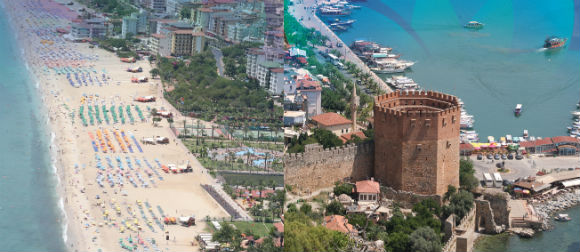
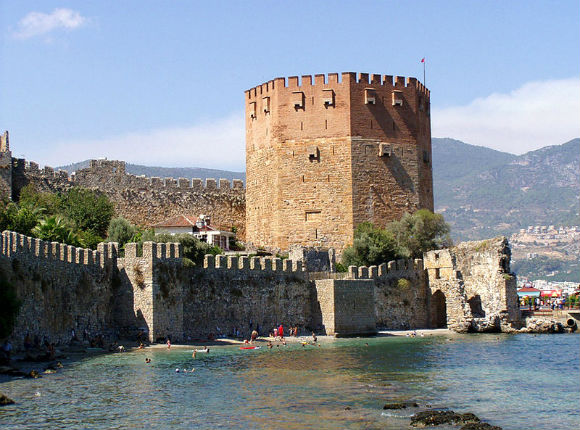
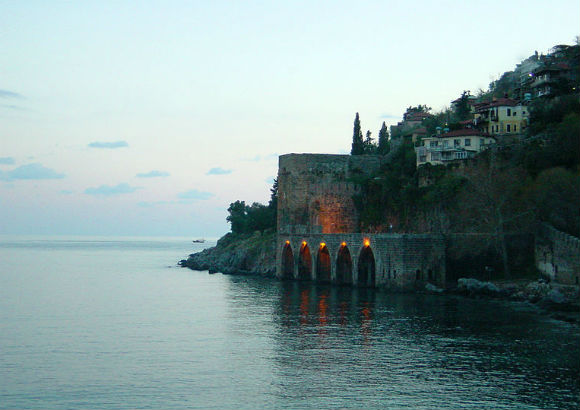
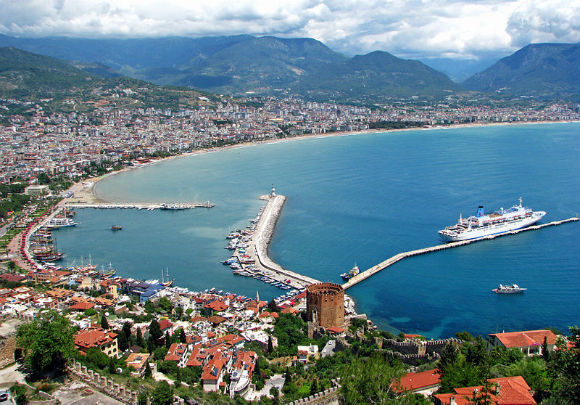
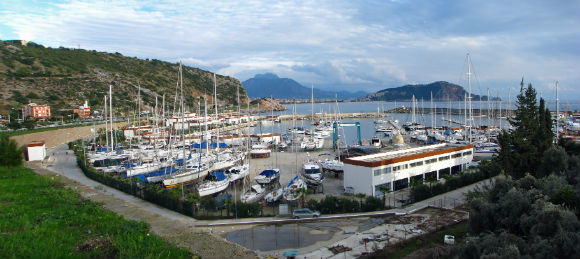


A really interesting history found on a recent visit. Fabulous views and a lovely setting with delightful cafes around. No4 bus goes up every 30 mins but not reliable. Last bus down is 8.30pm
Whether you want to walk up the mountain to see Alanya Castle is your decision. I took the public bus which leaves just opposite the tourist office every quarter past. It was only 2 Lira. There's a great view from the castle. Ticket to the castle is 10 Lira. Walked down and enjoyed the small paths through the village on…
We travelled up to the Castle by bus 1.5 lira each – the views were stunning. Well worth the trip up there. We took a slow walk back down the hill and there were plenty of cafes/bars to stop for a drink or to eat.
great views from the top,get a bus up to the top or it is a very long walk up a very steep hill.
We found these caves when we walked to Cleopatra Beach. It was cheap to go in and nice to see. You could take photos without anyone stopping you unlike the caves in Majorca which was banned "for strange reason"
As a group on young lads, we thought to ourselves "why do we want to go look at a castle?" but we didnt regret it one bit! Beautiful views are well worth it!
Very nice place, day and night. There is Alanya's oldest mosque, and the story of the
prison and its events is interesting. Recommend the guided tour there.
Especially at night Alanya lights are really beautiful.
The sand is beautiful, the beaches are fairly clean.
The waves are really dangerous, please be careful when venturing into the sea.
We make very beautiful pictures there with sunset. You can eat and drink something in a restaurant from maren beacht and you sit outside with a view you can not imagine. When you go to Alanya, you have to go to this place.
taxi up to castle 25 ntl. bus down -0.70ntl views from top are spectacular.castle is ruins but interesting.need good flat shoes and take your camera as scenery is spectacular. great 360 degree views. –small shop selling drinks and light snacks.would recommend the melon and honey smoothie- very tasty and refreshing